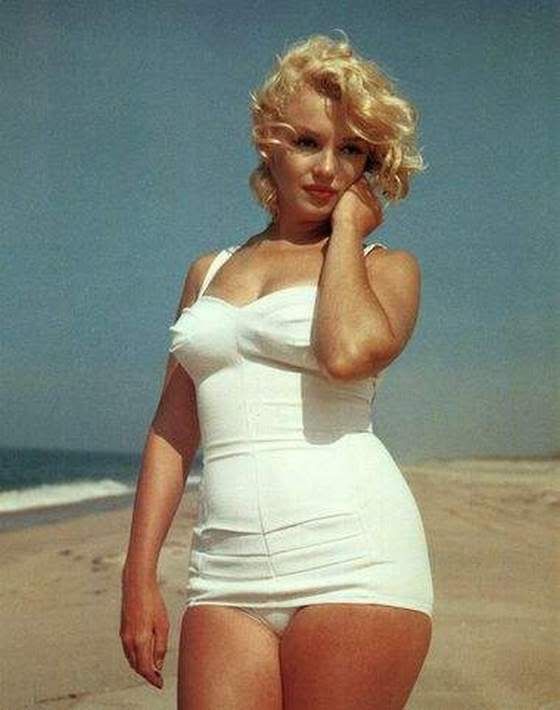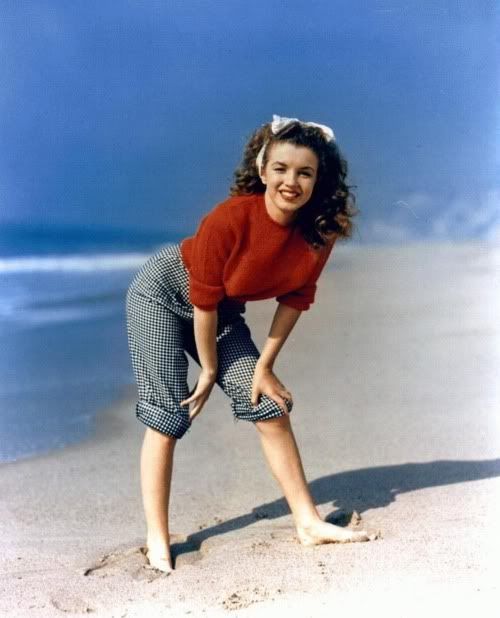This is Norma Jean Baker. You know her as one of the most famous sex symbols in movie history, Marilyn Monroe.
Whatever you personally feel about her or her work, we can all agree that she did an awful lot over the course of her career. It spanned less than fifteen years and her life was tragically cut off at 34 from a combination of mental illness and substance abuse. She died alone from an overdose of sleeping pills a virtual recluse, a sad ending to a life that was mostly very hard on her. In that very short space of time, she rose to rapid super-stardom and became Hollywood's biggest and most popular leading lady. She was also much, much more intelligent than the 'dumb blonde' she always played. She was a movie star, a model, a cultural icon, married and divorced several times, and a singer among rather a lot else.
Yes, Marilyn Monroe was a lot of things.
One thing she wasn't was a size sixteen.
It doesn't require more than the most casual glance to see that this supposed 'fact' doesn't have a lot to go on. Sometimes you kind of have to wonder if the people repeating it religiously have ever seen a photo of her. Even accounting for the fact that the dimensions of women's commercial numbered clothing sizes have changed over the years, this myth is still not true. The claims are either that she was equal to a modern size sixteen, or that she wore a sixteen in her own time and that translates to a different size today. And the difference is just one or two sizes, so it would still be equivalent to a twelve or fourteen. Semi-related: I've never been able to figure out why sizes are numbered the way they are. Men's sizes are done by waist x inseam, which is a way more practical method than arbitrarily assigning numbers--and children's sizes include all the numbers. Adult women's sizes, for some reason, are assigned increasing even numbers and adolescent girl sizes are assigned odd ones. None of which are consistent from one brand to another.
Anyway, what it comes down to is that Marilyn in no way looks like a size sixteen by anybody's standards. So either hundreds of photographs, movies, and production stills are pulling off a massive optical illusion (better than your best deceptive Facebook angles), or someone somewhere pulled this 'fact' out of their ass and it isn't true.
I understand why people repeat it and I understand why people want it to be true--confronted with an impossible and unattainable body-image standard, there's a lot of vindication and comfort in the idea that one of the greatest sex symbols of any age would, by modern standards, be considered plus-sized or even 'fat'. It makes us feel way better about ourselves.
But it isn't true.
Marilyn Monroe definitely wasn't a stick-person. (Your average model or actress today is a size two and rarely more than a size four.) Even in her own time she wasn't typical--then as now, actresses tended to be taller and thinner than the norm (think Audrey Hepburn), and Marilyn wasn't even five and a half foot tall with more curves than Lombard Street. It's hard to say what size she would have taken in her own day when she browsed the racks at Bloomingdale's since her famous dresses and costumes were all custom-fitted. But this is kind of a good thing, because if she bought all her clothes off the rack according to their numbered sizes, it would have been almost impossible to adequately dispel this myth. Sizes vary pretty dramatically from one brand to another and even sometimes within the same brands--just for a comparison, I wear a size six or eight most of the time but I own jeans that fit me perfectly as small as a size four and as big as a size ten because they were made by different manufacturers. Most of them are the same brand, too. So even if Marilyn bought size two jeans, that doesn't really tell us anything about her actual size.
Fortunately, her clothes were mostly tailor-made so dressmakers and studios had her measurements on file and still do. Because of her popularity, her iconic dresses (the pink form-fitting number from 'Gentlemen Prefer Blondes' and the infamous Subway Dress, for example) survive in museums and private collections and are easily measured. Rather than just unhelpfully saying she was size-X, we know what her dimensions actually were.
So what were they?
During her glory days in the 50s, her measurements were between 37-23-36 and 35-22-35.
First observation: that is a stupefyingly narrow waist. I'm normally called an 'hourglass' and my waist is 27. I think each of my thighs is 22 inches around. Her hips were pretty small, as well.
Second observation: she had some boobs there, didn't she?? Big busts are kind of the norm now but it's safe to say a good many of them are enhanced in some way with either a padded bra or surgery. (Very few people as rail-thin as modern models and actresses have enough body fat to have really big breasts like that.) Hers were an all-natural D-cup.
Third observation: there is absolutely, positively no way in hell anybody made clothes so small that those measurements counted as a sixteen. At the risk of offering a little too much information and sounding smug (which I'm not--I just want to prove a point), I wear either a six or an eight which, however I see it, isn't 'plus sized' and is actually smaller than average. (Average in the US is a size twelve.) My measurements are: 36-27-40. Except for her boobs, Marilyn was smaller than me and you can still get two of me into a typical size sixteen. I have no idea what I would have been by the smaller sizes of the 1950s, but I still wouldn't have been a sixteen. And if I'm not, then she definitely wasn't.
(And just for shits and giggles, the slender and willowy Audrey Hepburn's measurements were 34-20-34 and she was 5'7". She purportedly never weighed more than 105 pounds. Goddamn dancer physique.)
As I said, the differences in sizes makes it really hard to say for sure what measurements equal what sizes. Going by the size chart from Old Navy (for no other reason than because I happen to work there and that's where most of my jeans come from since they sell them in lengths and I have a really short inseam), her waist and hip measurements would let her comfortably fit into their size four. If she was picking out a dress and had to accommodate her bust, she would need a six. Much more than your standard-issue commercial or fashion model, but still nowhere near the sixteen dictated by this extremely pervasive myth.
It'll vary, of course, but it still comes down to this: Marilyn Monroe was equal to a modern size four or six.
She withdrew from the spotlight in the late 50s and didn't appear in any movies after 1960 (her last was released in 1961 but filmed a year earlier), after which she did gain weight, but the coroner's report from her autopsy lists her weight as 125 pounds. Even the most liberal distribution of that weight isn't very big. Again, I outweigh her by a good fifty pounds (of which almost none is muscle) and I'm still not a size sixteen. She was unlikely to have measured more than a modern size eight.
A quick and unsubstantiated guess as to what all this equaled when she was alive and wearing all those fabulous clothes is most likely between a six and a ten. I tried looking it up and found numbers as small as a six and as big as a twelve, but six and ten is probably the most likely range for her day.
I know why we so badly want this to be true and repeat it like gospel. 'Marilyn Monroe was plus-sized!' as an argument is guaranteed to pop up in any real-world or internet forum discussion on female beauty standards. Otherwise respectable and intelligent people--including several of my teachers and feminist professor Gina Barreca--have stated it as fact. Because, goddammit, if a size sixteen was good enough for the quintessential blonde bombshell then it's good enough for me! But simply saying it doesn't make it true.
Incidentally, she also wasn't a natural blonde. She was brunette. That signature platinum bob was the result of a lot of peroxide and she didn't start dying it until she began acting in movies--supposedly she did live with an aunt when she was eight who bleached her hair and made her wear all white, but I don't know whether or not this is true so I'm not going to state it as fact. Photos of her as old as her early twenties (the late 40s) have her with her natural hair colour--the blonde was just more commercial at the time and you kind of have to admit it suits her more.
I don't know when this was taken but she doesn't look as though she could be much older than about eighteen. She was still gorgeous as a brunette but ultimately the effect is completely different with that curly brown hair and the bow. It might be bias or it might be that the default image of her is as a blonde, but it's hard to picture her standing over a subway vent looking like this. The curls, the bow, the baby-face, and the dimples send her Cuteness Factor through the roof but she almost looks too wholesome to be a sex symbol.
And she isn't a sixteen here, either.
My position isn't one of ignorance. I'm not one of the very small number of lucky women who effortlessly and seamlessly comply with the standards of female attractiveness. You can certainly influence--but not entirely control--your weight and body fat content with a carefully regulated diet and regular exercise, but like height your body type is determined largely by genetic factors beyond your control. Barring doing something extreme, you aren't going to be rail-thin if you're not programmed that way. And I'm definitely not. I'm among the 95% or so of the female population with a different body type than that impossibly tall and skinny one. I'm pretty substantially overweight, especially for my height (I'm five foot), and at no point in my adult life have I been less than 120 pounds which still medically qualifies as being overweight. I currently weigh about 170 or so, which puts me comfortably in the range of obesity, and as I stated, my measurements aren't unrealistically tiny.
However badly we want to be able to dispute what we mostly accept anyway--that such exacting standards are unfair and unattainable--you can't do that by repeating a myth. Marilyn was certainly no stick-person but neither was she plus-sized.
But it doesn't matter. None of this does. Whether Marilyn Monroe was a six or a sixteen, she was still beautiful. In the end, the arbitrary number assigned to her and Audrey and Angelina and all the other icons of our or any other age don't matter. You're beautiful, too, in your own way, and it has nothing to do with the number on the tag in your jeans.
It's nice to feel good about yourself. It's nice to see your own attributes and to be comfortable with yourself. It's healthy. It's realistic. It'll probably make you a lot happier.
But Marilyn Monroe doesn't have to have been a size sixteen in order for you to do it.


No comments:
Post a Comment